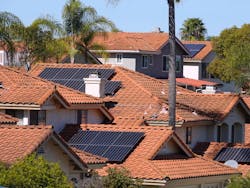The Greening of California Continues with Upcoming Energy Storage Solicitations
The California Energy Commission (CEC) Oct. 30 will release two energy storage solicitations totaling $31 million to support the state’s goal under SB 100 of attaining 100% fossil-free electricity by 2045.
The commission wants to get the word out now because preparing energy storage projects and proposals can be time consuming, said Mike Gravely, CEC research program manager.
“We are doing this to bring new technologies that are cheaper and better performing to meet SB 100,” he said, adding that existing technology isn’t capable of meeting the requirements of the legislation.
Solar rooftops are increasingly common in California, and energy storage is a companion technology. Photo by Simone Hogan/Shutterstock.com
Among the new technologies the commission focuses on are microgrids — and energy storage plays an important role in them, he said.
“Microgrids help integrate these clean technologies. These are the solutions we need to reverse the impacts of climate change.” Gravely noted that the focus on energy storage will help move microgrids along. All the microgrids that have received commission funding include energy storage.
Details on energy storage solicitations
Proposals for the energy storage projects will be due by the end of the year, and the commission will issue the awards between April and June, he said.
The first of the two energy storage solicitations is for $20 million and seeks technology demonstration projects in four categories.
“This is for projects that are maybe on the second generation of design,” said Gravely.
The four categories are:
- Energy storage that supports durations of 10 hours or more
- Residential energy storage compliance options
- Technologies that can support disadvantaged and low income communities
- Energy storage to support Native American tribes
The second of the energy storage solicitations, for $11 million, is for applied research projects, which are pre-commercial. The commission expects to sign about five to seven agreements for this solicitation.
The $11 million solicitation “will help companies get their first demo running, and can be a big step for companies that want to demonstrate their potential,” said Gravely. This solicitation will develop customer-side-of-the-meter energy storage technologies that provide increased energy density. They should address needs such as resiliency, reliability, improved safety, better long term or lifecycle performance and lower costs than systems now operating.
One goal of the solicitations is to focus on non-lithium ion solutions, said Gravely.
“We are looking at all technology, but focusing on non-lithium ion storage. It is considered mature. We want to give non-lithium ion opportunities to advance,” he said.
Project participants must spend 60% of the funding in California, he noted.
California continues work on DER roadmap
Meanwhile, the commission is working on a distributed energy resources (DER) research roadmap. On Sept. 17 it will hold the second of three public workshops on the map. Working with Navigant Consulting, the workshop will summarize the research ideas submitted for the roadmap and share preliminary results of the commission’s scoring of the research ideas. The roadmap aims to develop and prioritize DER research recommendations.
Gravely noted that distributed energy is an important component of microgrids. The microgrids funded by the commission were required to incorporate at least three forms of distributed energy.
The commission also has undertaken roadmaps for microgrids, electric vehicles and demand response, he said.
These roadmaps lead to project funding. For example, the microgrid roadmap led to $51.9 million in grants for 10 microgrids.
The commission had originally planned to provide $44.7 million for microgrids but increased the amount after reviewing the 60 grant applications it received from a solicitation issued in August 2018 (GFO-17-302).
Zero carbon depends on storage
Overall, the goal of the storage, DER and microgrid projects is to meet California’s ambitious goal of achieving a zero carbon grid by 2045 and to meet the requirements of SB 100, which was passed in September of 2018. That means finding ways to improve technologies and lower their costs.
SB 100 was one of a number of clean energy initiatives passed by California lawmakers in 2018. The legislation is the result of efforts by a movement that has been pushing 100% clean energy worldwide since the early part of the century.
The law requires California to get 50% of its electricity from renewables by 2025 and 60% by 2030. For the final 2045 goal, California dropped the term renewables and instead used 100% zero carbon electricity. This broader language recognizes that technologies other than renewable energy might contribute to a clean electric grid by 2045.
“As California tries to reach zero carbon by 2045, the perception is storage will be big,” said Gravely. “We need larger scale and more diverse technologies. The goal is to get cheaper, longer lasting storage, which is what every microgrid in the world wants.”
Track news about microgrid and energy storage solicitations. Subscribe to the free Microgrid Knowledge newsletter.
About the Author
Lisa Cohn
Contributing Editor
I focus on the West Coast and Midwest. Email me at [email protected]
I’ve been writing about energy for more than 20 years, and my stories have appeared in EnergyBiz, SNL Financial, Mother Earth News, Natural Home Magazine, Horizon Air Magazine, Oregon Business, Open Spaces, the Portland Tribune, The Oregonian, Renewable Energy World, Windpower Monthly and other publications. I’m also a former stringer for the Platts/McGraw-Hill energy publications. I began my career covering energy and environment for The Cape Cod Times, where Elisa Wood also was a reporter. I’ve received numerous writing awards from national, regional and local organizations, including Pacific Northwest Writers Association, Willamette Writers, Associated Oregon Industries, and the Voice of Youth Advocates. I first became interested in energy as a student at Wesleyan University, Middletown, Connecticut, where I helped design and build a solar house.
Twitter: @LisaECohn
Linkedin: LisaEllenCohn
Facebook: Energy Efficiency Markets

